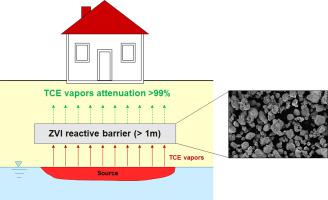Journal of Contaminant Hydrology ( IF 3.5 ) Pub Date : 2020-07-19 , DOI: 10.1016/j.jconhyd.2020.103687 Daniela Zingaretti 1 , Iason Verginelli 1 , Igor Luisetto 2 , Renato Baciocchi 1

|
Chlorinated solvents are extensively used in many activities and hence in the past decades impacted a large number of sites. The presence of these contaminants in groundwater is challenging particularly for the management of the vapor intrusion pathway. In this work we examine the potential feasibility of using horizontal permeable reactive barriers (HPRBs) placed in the unsaturated zone to treat chlorinated solvent vapors emitted from groundwater. Zero-valent iron (ZVI) powders, partially saturated with water and characterized by different specific surface areas (SSA), were tested, alone or mixed with sand, in lab-scale batch reactors using TCE as model compound. Depending on the type of iron powder used, a reduction of TCE concentration in the vapor phase from approximately 35% up to 99% was observed after 3 weeks of treatment. The best performance in terms of TCE reduction was obtained using the ZVI characterized by the intermediated values of the specific surface area (SSA). This finding, which is in contrast with the results generally observed in in aqueous solutions, was tentatively attributed to a non-selective higher reactivity of the fine-grained iron samples with water and dissolved oxygen (with a consequent iron passivation) or to the occurrence of a diffusion-limited reaction kinetics. Based on the first-order kinetic degradation rate constants estimated from the experimental data, a horizontal barrier of 1 m containing ZVI or a mixture of ZVI and sand can potentially lead to an attenuation of TCE vapors over 99%.
中文翻译:

具有零价铁的水平可渗透反应性阻隔层,用于防止氯化溶剂蒸气在不饱和区中向上扩散。
氯化溶剂广泛用于许多活动中,因此在过去的几十年中影响了许多场所。这些污染物在地下水中的存在尤其对蒸气侵入途径的管理具有挑战性。在这项工作中,我们研究了使用置于非饱和区中的水平渗透反应性屏障(HPRB)处理地下水排放的氯化溶剂蒸气的潜在可行性。使用TCE作为模型化合物,在实验室规模的分批反应器中单独或与沙子混合测试了部分饱和水且具有不同比表面积(SSA)的零价铁(ZVI)粉。根据所用铁粉的类型,处理3周后,气相中TCE的浓度从大约35%降低到99%。使用ZVI可获得最佳的TCE降低性能,其特征在于比表面积(SSA)的中间值。该发现与通常在水溶液中观察到的结果相反,暂时归因于细粒铁样品与水和溶解氧的非选择性更高的反应性(随之发生的铁钝化)或发生的原因。扩散受限的反应动力学。根据实验数据估算出的一级动力学降解速率常数,包含ZVI或ZVI和沙子的混合物的1 m的水平屏障可能会导致TCE蒸气衰减超过99%。这与通常在水溶液中观察到的结果相反,暂时归因于细粒铁样品与水和溶解氧的非选择性更高的反应性(随之发生的铁钝化)或扩散的发生有限的反应动力学。根据实验数据估算出的一级动力学降解速率常数,包含ZVI或ZVI和沙子的混合物的1 m的水平屏障可能会导致TCE蒸气衰减超过99%。这与通常在水溶液中观察到的结果相反,暂时归因于细粒铁样品与水和溶解氧的非选择性更高的反应性(随之发生的铁钝化)或扩散的发生有限的反应动力学。根据实验数据估算出的一级动力学降解速率常数,包含ZVI或ZVI和沙子的混合物的1 m的水平屏障可能会导致TCE蒸气衰减超过99%。











































 京公网安备 11010802027423号
京公网安备 11010802027423号